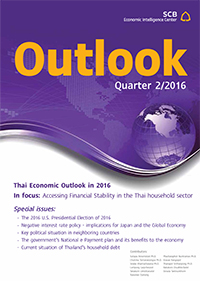Outlook Quarter 2/2016
EIC forecasts that the Thai economy in 2016 will grow 2.5%. The pace slows from the previous year as the economy still faces downward pressures from both external and internal factors. The Thai economy will need to rely on the government’s supports for economic stimulus measures and public investment. Economic measures, such as assistance programs for farmers, income tax reduction and investment incentives, will be the main supporting factor for the recovery of private domestic demand; while the outlook of household income remains suppressed, reflected by lower working hours in both farm and nonfarm sectors, as a result of shrinking exports, drought and the high level of household debts. Additionally, public investment is also another hope as an economic driver this year. Public investment registered a record-high growth last year and will likely expand further this year considering the 20% increase of the planned budget. The construction of the new metro lines in Bangkok and Motorways will also be key to bring back investor confidence and private investment going forward; while other infrastructure projects will need to be kept on a close watch for possible delays.
 |
|
Thai Economic Outlook in 2016
EIC forecasts that the Thai economy in 2016 will grow 2.5%. The pace slows from the previous year as the economy still faces downward pressures from both external and internal factors. The Thai economy will need to rely on the government’s supports for economic stimulus measures and public investment. Economic measures, such as assistance programs for farmers, income tax reduction and investment incentives, will be the main supporting factor for the recovery of private domestic demand; while the outlook of household income remains suppressed, reflected by lower working hours in both farm and nonfarm sectors, as a result of shrinking exports, drought and the high level of household debts. Additionally, public investment is also another hope as an economic driver this year. Public investment registered a record-high growth last year and will likely expand further this year considering the 20% increase of the planned budget. The construction of the new metro lines in Bangkok and Motorways will also be key to bring back investor confidence and private investment going forward; while other infrastructure projects will need to be kept on a close watch for possible delays.
Bull - Bear: Oil Prices
EIC’s view: BEAR
Crude oil prices in the second quarter of 2016 will likely remain at a low level due to the existing imbalance of demand and supply. The oil market is filled with 1.4 million barrels per day of excess supply. A number of rigs in the US have improved their production efficiency. As a result, supply from the US may not fall as much despite the decreasing rig count. Moreover, the meeting between OPEC and Russia in Qatar failed to agree on a production freeze as Iran wanted to raise their production and exports after the lifting of sanctions. This will continue to put downward pressures on oil prices.
In focus: Accessing Financial Stability in the Thai household sector
The problem of household debt has received much attention because its effects are interlinked with many sectors in the economic system, including households, financial institutions, and businesses. These agents have concerns over the high ratio of household debt to GDP that is currently standing at 80%. This ratio has quickly climbed, and its current level is now higher than that of countries with similar income levels (see further in BOX: Current situation of Thailand’s household debt). Low-income households are even more worrying because they have larger debt burdens than mid- and high-income households.
However, previous analyses have only looked at household debt without considering the overall financial positions of households, such as asset holdings and liquidity. Applying the balance sheet concept used by firms, this edition of In Focus presents an analysis of household balance sheets that considers a household’s financial position through assets, liabilities, and equities. This information will improve our understanding of household financial stability in Thailand. Thailand’s household balance sheets are compiled and calculated from data from the Socio Economic Survey (SES) collected by the National Statistics Office.